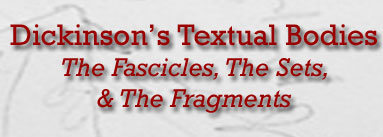

Fascicles.
Taken together, the 40 fascicles, containing approximately half--814--of Dickinson's extant poems, comprise one of the central embodiments of her work. Our first task, then, is to consider the forty fascicles as a single site of writing in order to a) to analyze the various stages involved in the construction of the fascicles, from the copying of poems from rough drafts, to the arrangement of poems in a given fascicle, to the final binding of poems, and b) to theorize about alternative reconstructions of the fascicles in cases where there are problems with the reconstruction of the fascicle structure in The Manuscript Books of Emily Dickinson.
Our second task involves more closely focused work with the following fascicles: 1; 2; 5; 7; 10; 15, 16; 34; and 40. Since Dickinson almost certainly initially conceived the first fascicle as a model for later fascicles, the analysis of her use of bibliographical codes, her choice of poems, her arrangement of leaves, etc. in this inaugural fascicle may aid us in understanding how she initially understood her poetic project and how her understanding of the project changed and developed between 1858 and 1864. Fascicle 2 has suffered mutilation, probably at the hands of someone intimate with Dickinson (if not with her work). It raises important questions about the censorship of Dickinson's work--and particularly about the censorship of her relationship with Susan Dickinson--by members of her family and perhaps by her early editors that will return in later discussions focusing on the disfiguration of her manuscripts in the printing press. Fascicles 5 - 12 are important transitional fascicles. In discussions of these fascicles we will identify and analyze internal signs of crisis or change in the fascicle structure. In fascicle 5, for example, Dickinson introduces the first unresolved variant into the fascicles, marking a significant shift in her initial conception of the fascicles as a stable record of finished poems. In fascicles 10 and 11, further signs of crisis are manifested in Dickinson's obsessive use of exclamation points, quotation marks, and underlinings, as well as in the breakup of stanzaic forms--especially the quatrain--that had been privileged in fascicles 1-9. In fascicle 12, Dickinson introduces a new method of displaying variant readings (variant readings now appear below the body of the poems proper) that appears to indicate a commitment to including and multiplying variant readings in her "finished" poems. Fascicle 34 contains some of Dickinson's most powerful poems on poetry ("My Life had stood - a Loaded Gun," "These - saw Visions -," "Essential Oils - are wrung") and on the possibilities and limits of literary community ("Bereavement in their death to feel"; "These - saw Visions"; and "Strong Draughts of Their Refreshing Minds"). Fascicle 40 requires us to consider reading as an act of retrospection--and re-reading.
Sets.
Our discussions of the sets will focus on the reasons Dickinson may have stopped binding her work into books and on her reasons for choosing the single sheet as the preferred unit of composition. Are the sets and especially the late drafts and fragments evidence of what David Porter called "the losing of the program for poetry," and, if so, what does this mean? At last, we review the history of the first phase of the editing of Dickinson's manuscripts and consider the implications for readers of the decision by her first editors to dismantle the fascicles. We may, depending on student interest, spend some time decoding Mabel Loomis Todd's notebooks, the single most important tool for reconstructing Dickinson's packets.
Fragments.
For a detailed discussion of the fragments, see "'Most Arrows': Autonomy and Intertextuality in Dickinson's Late Fragments," Radical Scatters: An Electronic Archive of Dickinson's Late Fragments and Related Texts, ed. Marta L. Werner. Ann Arbor: U of Michigan P, 1999.